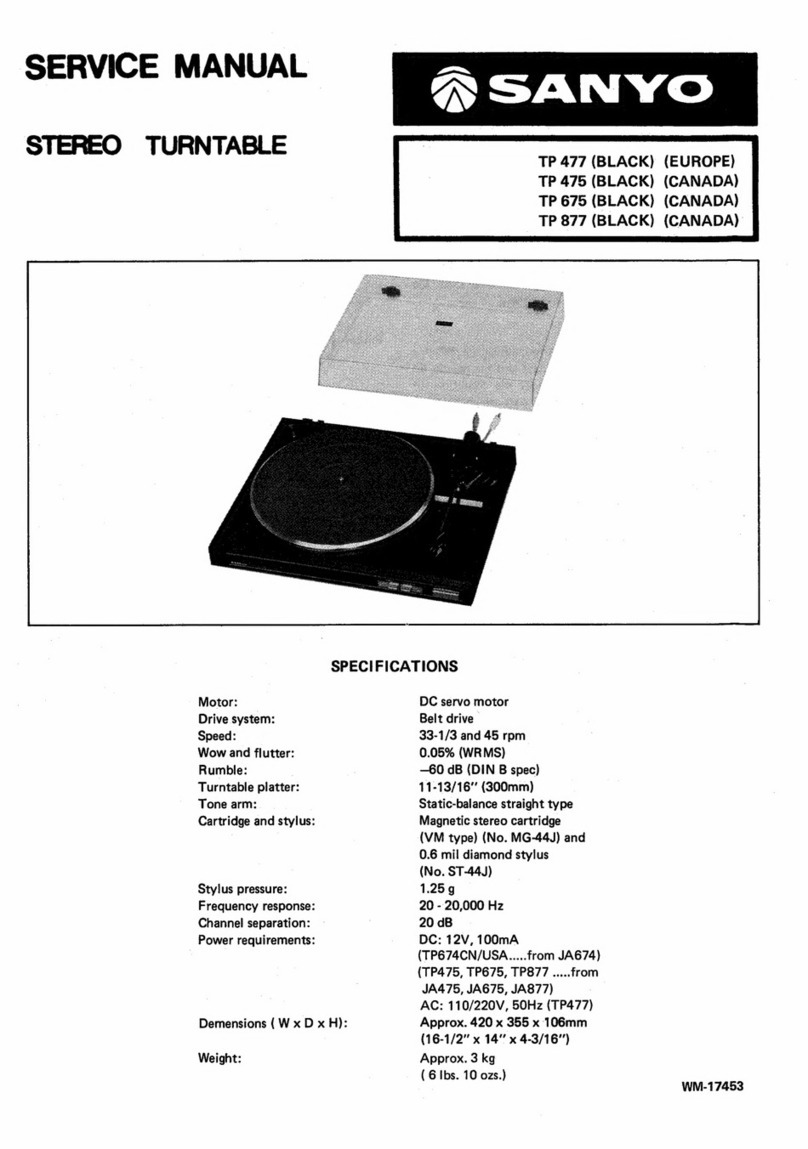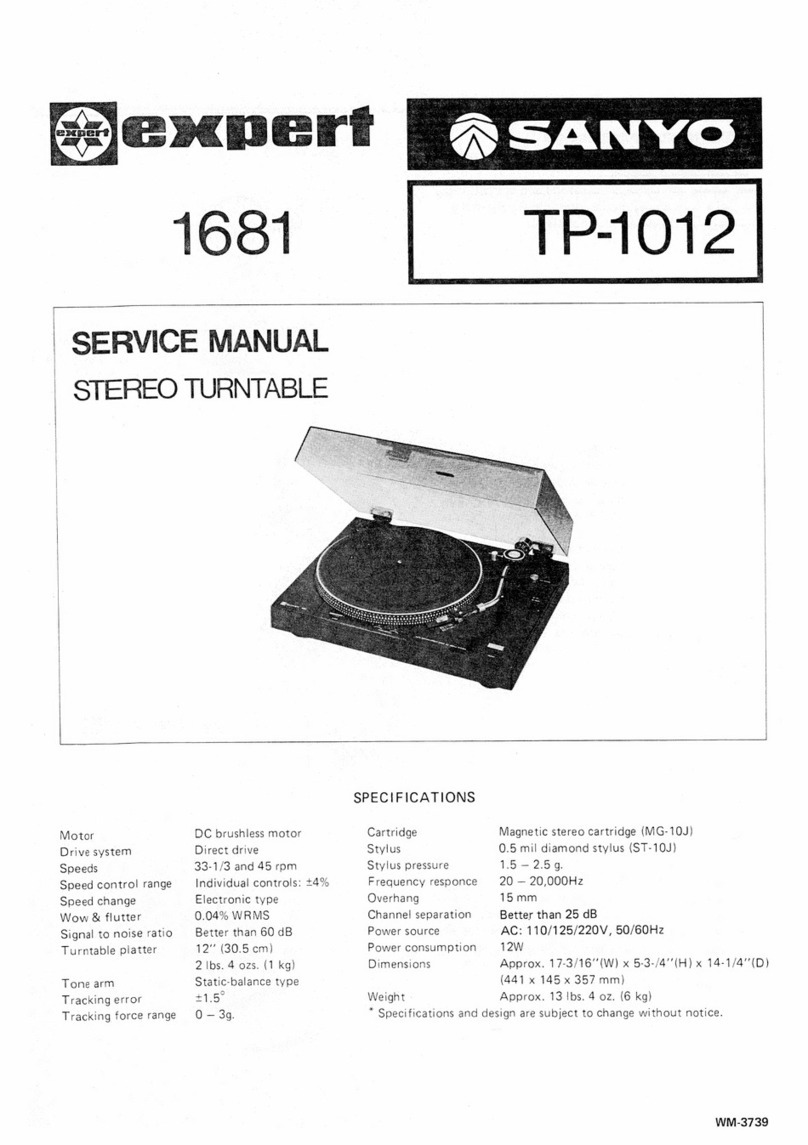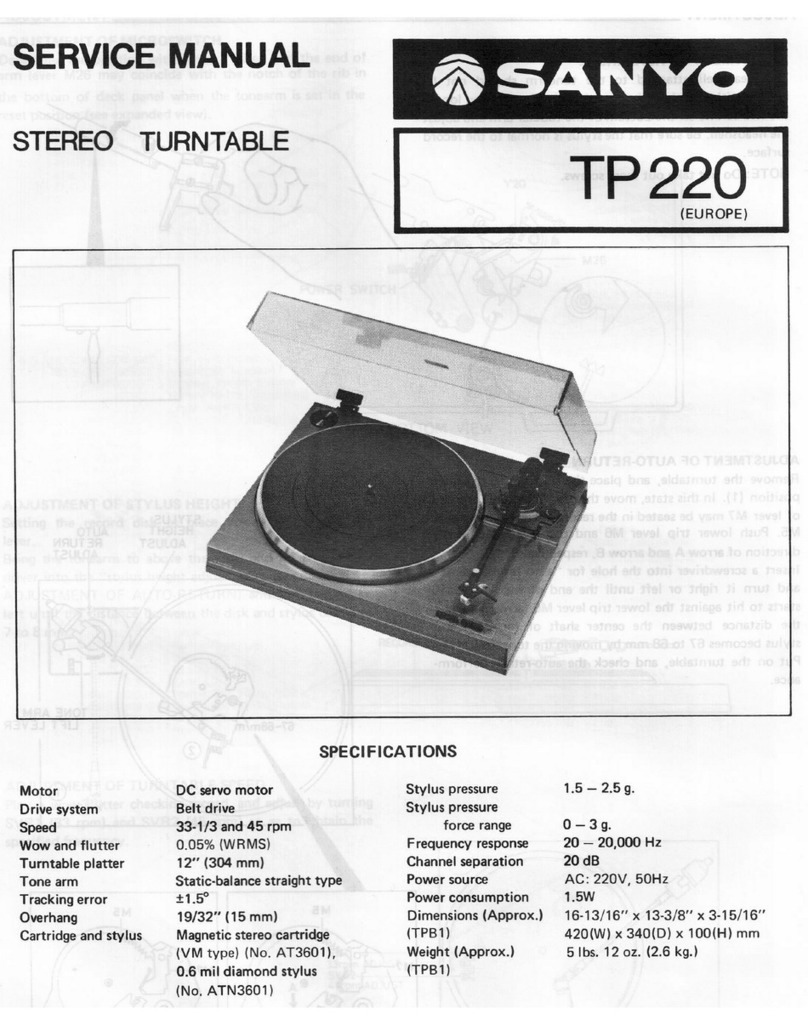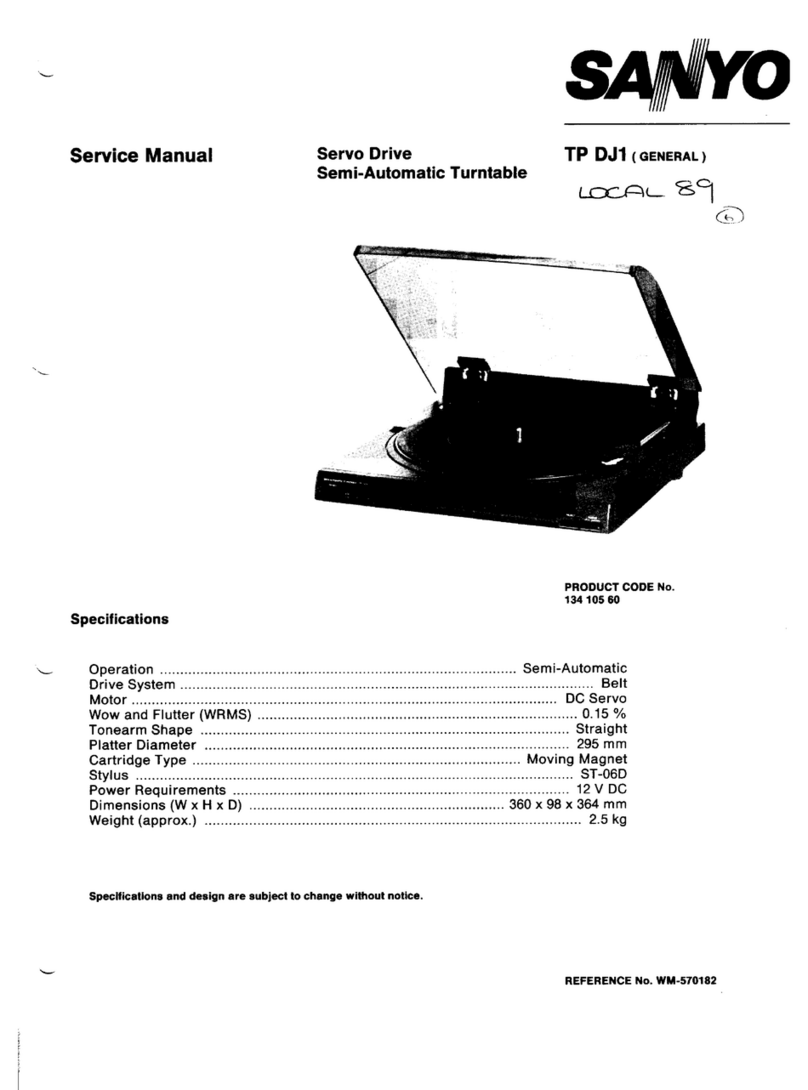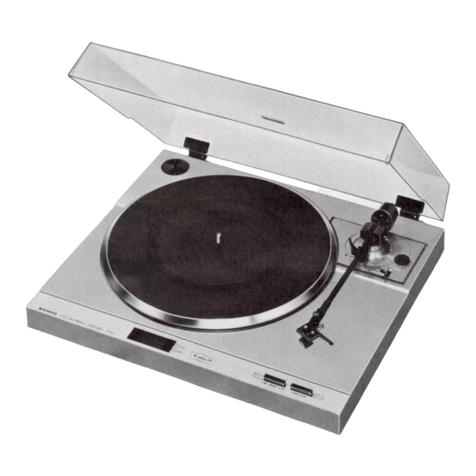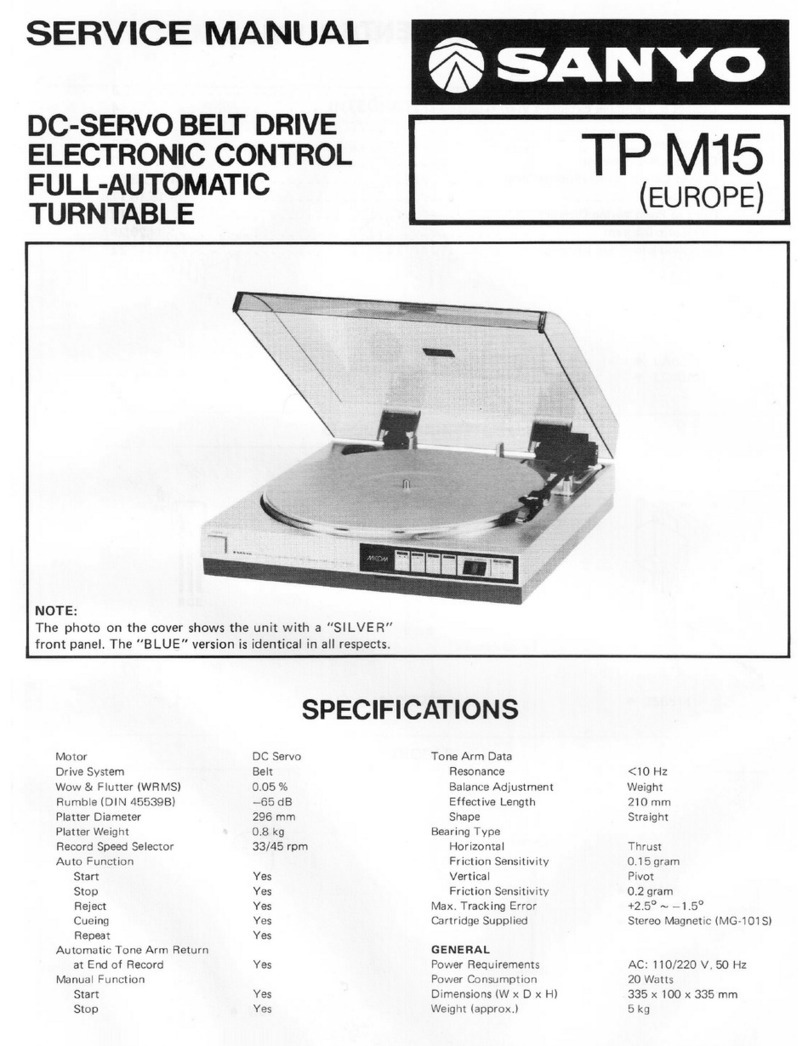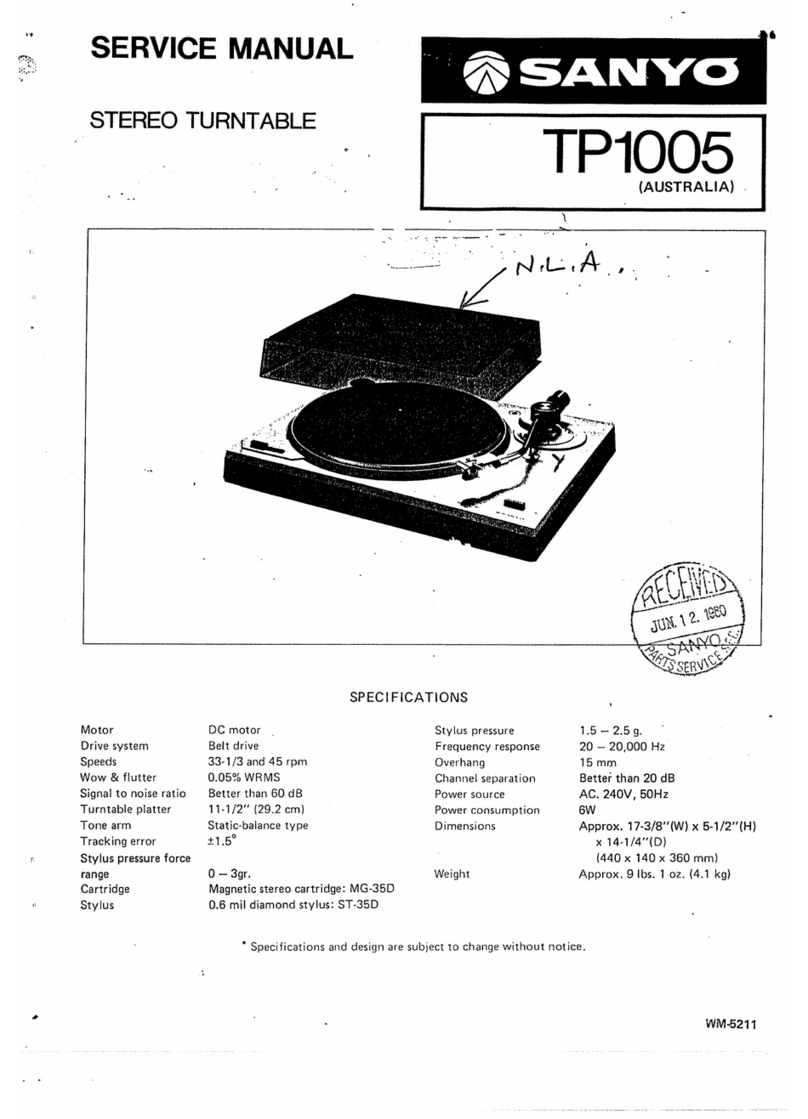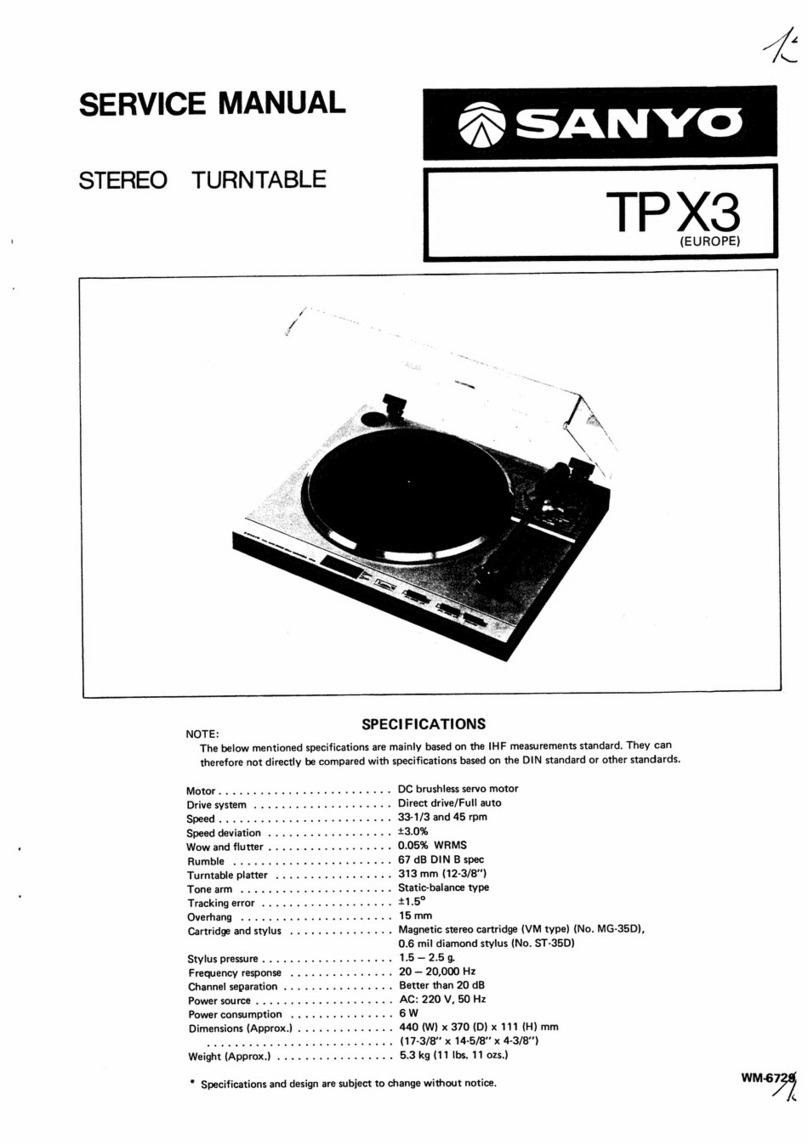
BRIEF DESCRIPTION OF CONTROL SWITCHES
This unit is provided with soft-touch control switches, and is
composed of digital circuits. The control switches are nine all-
together: start/stop, repeat, disc size (12", 10" and 7 "), rotational
speed (33 rpm and 45 rpm), quartz-lock and cue.
The start/stop switch changes over alternately, the cue, repeat and
quartz-lock switches are on and o ff alternately, and the disc size
switches and the rotational speed switches are, when pushed, set
to the settings that correspond to labels shown on them. Tuning
on the power switch (S10) closes the play switch (S14), starting the
main motor.
INITIALIZATION
Energizing the unit actuates the IN ITIA LIZ E circuit at once, setting
the initial action of every switch. The IN ITIA LIZ E circuit is
composed of C9, R13 and IC8, and its output goes high only during
a period of time that is equal to CR time constant. The high-level
output clears (CL) repeat and cue functions, set disc size to 12" and
rotational speed to 33 rpm, and locks the quartz circuit.
1. The output of the IN IT IA LIZE circuit enters the cue flip-flop
IC7 (trigger flip -flop) by its CL (clear) terminal (pin no. 4),
which clears the IC7 to depress its output Q to low, making the
subsequent circuits inactive.
2. The above-mentioned high-level ouput also enters the quartz
lock flip-flop IC6 (trigger flip-flop) by its PR (preset) terminal
(pin no. 6), and presets the IC-6. This raises its ouput Q to high,
triggering the LED driver Q7 to light the LED D8. By contrast,
another output Q goes low, which makes the IC10 (relay driver)
and therefore the relay (RL-1) inactive. This keeps the relay
terminal in NC (normal close) state, causing short circuit
between the quartz PLL of motor PCB and the common
terminal to put the unit in the quartz-look state.
3. The said output, high in level, is impressed on the S terminal
(pin no. 12) of disc size 12" flip-flop IC5 (R-S flip-flop) by way
of or gate IC3 to set the IC5, thereby raising its output Q to
high. This triggers the LED driver Q3, lighting the LED D4.
Besides, the output of the IN IT IA LIZE circuit is impressed by
way o f the or gate IC3 on R terminals (pin nos. 7 and 15) of disc
size 10" and 7" flip-flop IC5s to reset them. As a result, outputs
Q of the both IC5s go low to make the follow ing circuits inactive,
setting disc size to 12” in terms of mechanism.
4. The output of the IN ITIA LIZ E circuit enters the repeat f lip
flop IC6 (trigger flip-flop ) by the CL (clear) terminal (pin no.
11) to clear the IC6. This leads to depression of its output to
low, making the following circuit inoperative.
5. Besides, the output of the IN ITIA LIZ E circuit enters the
rotational speed selection flip-flop IC5 (R-S flip-flop) by its R
terminal (pin no. 4) via diode D12 (or gate) to reset the IC5.
Output Q delivered from the IC5, low in level, triggers the LED
'driver Q2 to light the LED D2.
In addition, the low-level output Q sets the 33/45 rpm terminal
of main-motor PCB to the "33 rpm " position.
START/STOP
The push of the start/stop switch after completion of initialization
drives the sub-motor, starting the arm. If record playing comes to
an end, both the play (S13) and remain (S12) switches open,
stopping the sub-motor.
1. The push of the start/stop switch permits a signal to enter the
monostable multivibrator (one-shot) circuit IC1 via the or gate
D9. The output delivered from that circuit is held high for
about tw o seconds after the push of the above switch. The
sub-motor drivers Q1 and Q2 are kept on only for that period
of time, and the resulting current flo w from the Q2 starts the
sub-motor. The play and main switches close then, permitting
current flow to reach the sub-motor about two seconds later
by way of the both switches S12 and S13.
CUE
The push of the "cu e " switch during playing a record lifts the arm
up, and one more push resumes the operation at the same phase as
before cue is given, permitting the arm to descend on the record
surface for playing.
1. The push of the "cue" switch causes a signal to enter the mono
stable m ultivibrator (one-shot) circuit IC2, and an output
delivered from that circuit is held high for 10 msec after the
above-mentioned switch has been pushed. The high-level output
enters the IC7 by its clock terminal (pin no. 3) to reset it.
Output Q of the IC7 goes then high, triggering the plunger
driver IC10 to drive the cue plunger o f MG-3, and at that very
instant the LED D1 lights up as well. Meanwhile, another IC7
output Q goes low, and triggers the plunger drivers Q8 and Q9
(Darlington circuit) by way of the time constant circuit compos
ed of C12, R17 and IC2 — which holds input conditions for 8
to 9 seconds, thus driving the plunger of MG-3.
* The Q side supplies plunger driving current for initial driving,
while the Q side does hold current necessary after plunger
driving.
ROTATIONAL SPEED CHANGING-OVER
The rotational speed of turntable platter is initially set to 33 rpm
owing to initialization, but can be changed over to 45 rpm with
the push of the 45 rpm switch.
1. Pushing the 45 rpm switch permits a signal to enter the IC5 by
its S terminal (pin no. 4), setting the IC5. Its output goes then
high, causing the LED D2 to go out and the 33/45 rpm terminal
o f main PCBto be set to 45 rpm. Besides, that output triggers
the relay driver 1010 to drive the relay RL-2.
As a result, the relay terminal is brought to the NO (normal
open) side, thereby providing rotational speed adjustment to
45 rpm unless the quartz-lock is in action. The LED D3 lights up
as soon as the above relay is driven.
2. The push of the 33 rpm switch permits a signal to enter the IC5
by its R terminal (pin no. 3) via diode D11 for resetting it.
The subsequent behaviors are quite the same as in "In itia liza
tio n ".
DISC SIZE CHANGING-OVER
The disc size setting is initially adjust to 12" owing to initialization,
but can be changed to 10" or 7" with the push of the 10" or 7"
switch.
1. By pushing any one of three disc size change-over switches, 12” ,
10" and 7 ", the IC5 is set through the selective circuit inside
the IC3, which resets any other switches than the pushed one.
In detail, if the 10" switch is pressed, fo r example, the IC5 is
set, raising its output Q to high. This triggers the LED driver Q4,
lighting the LED D5. The above output arrives just then at the
input terminal (pin no. 13) of nand gate IC8,and IC5 output Q
goes low at pin nos. 1 and 10, putting out the D4 and D6.
Furthermore,,the output delivered from pin no. 1 of the IC5
enters the IC8 by its input terminal (pin no. 12). Linder this
condition the cathode sides of both the D17 and the D18 go
high, which triggers the plunger driver 1010 to drive the plunger
of MG-2. Thus, disc size is set to 10".
* Diodes D17 thru D20 make up a circuit that is responsible for
preventing faulty operation. The circuit is so designed as to set
disc size to 12" as soon as IC8 inputs are simultaneously high.
- 1 -



